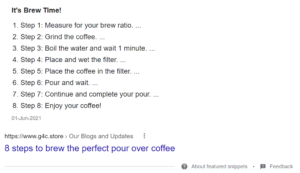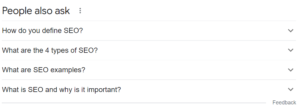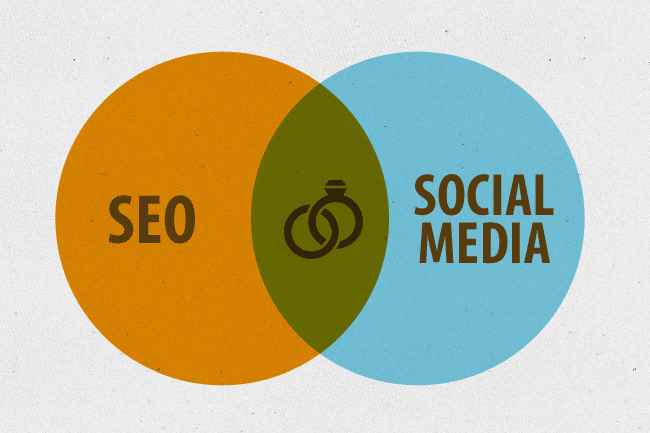Google is constantly testing and changing the Search Engine Page Layout to bring in new types of results for users to improve the user experience. Some standard SERP features are Knowledge Graphs, People Also Ask, and Featured Snippets. This blog will discuss featured snippets, what featured snippets are, and how to optimize your web page to rank for featured snippets. Webmasters love to get their web pages into Google featured snippets, and the reason for that is apparent. Featured snippets get the website more clicks, improved CTRs, increased conversions, and appear on top of SERP.
Now the question is, Is it worth optimizing for featured snippets?
The answer is yes; It’s worth optimizing webpages for feature snippets as, according to Search Engine Land, featured snippets get approximately 8% of overall clicks.
Now that you have enough reasons to focus on featured snippet optimization let’s understand featured snippets and techniques to optimize the webpage for them.
It’s not easy to manage SEO activities by an in-house team as it requires a lot of skills and work, and optimizing for featured snippets is not easy as there are many inputs, from finding opportunities to optimizing content to rank for them. You might want to consider hiring professional SEO services to improve your organic presence.
Jump in!
What are Featured Snippets?
Position #0 results on the search engine ranking page are often called featured snippets. These are snippets of text that appears on the top of the result page. Basically, featured snippets are pulled by Google from indexed web pages and intended to give users quick responses.
The most common types of featured snippets are definitions, tables, unordered lists, ordered lists, and steps.
Featured snippets are important for SEO as they are a great way to get more clicks from organic results without ranking higher, and they also increase the CTR for the website.
Ways to Optimize for Featured Snippets
Use Google to Unwrap the Featured Snippets Opportunities
Mostly long-term search queries or information-related queries appear in snippets, so you will have to look for such terms for which Google is showing the snippets.
There are two ways to find these terms: manually check the keyword on the search engine, using SEMrush or Ahrefs to find the keywords showing featured snippets in SERP.
Once you have a list of relevant keywords that shows featured snippets, you can start working on putting them together and plan for optimization.
Also, search queries for questions or information-related keywords will have a higher chance of ranking for snippets.
Optimize the Content
Content optimization is an essential part of SEO, and the same rule applies while optimizing for a featured snippet.
Here are the ways to optimize the content for different types of featured snippets
Featured Snippet for Definitions:-
Write the definitions or answer questions like “What is Y” in 40-60 words, as Google mostly shows 50-60 characters in the snippet.
Other points to note here are provided word-to-word definitions, not including personal opinions in the content, and being crisp.
Featured Snippet for Tables:-
Keywords for which tables are appearing in the SERP, create a table in between the content targeting the keyword.
Google will mostly pick up the whole table in a snippet rather than collecting the data from different parts of the webpage.
Featured Snippet for the Ordered List:
Mostly the keywords, including steps, will be coming up on the SERP for this type of snippet.
You need to format the blog with Steps in H2’s like Step #1, then Step #2, which should be formatted in the identical format.
Google will pick up the data from H2’s and show the result in the snippet.
Featured Snippet for Unordered List:
Keywords related to tips and tricks will rank for the unordered type of snippet on the Google Search Page.
Keep the formatting simple, and Google might pick them for the snippet.
Tips to Rank for More Featured Snippets
Tip#1 Do the Proper Keyword Research
Snippets mostly appear on the long tail search terms, how-to keywords, what-is queries, and information-seeking keywords.
Research for these keywords and related topics using tools like Semrush, Ahrefs, Answer the Public, and AlsoAsked.
Once you have the list of keywords, structure the content to cover these topics and answer the user query within the content itself.
Answering the query with precise content will increase the chances of appearing in the featured snippet.
Tip#2 Look at People Also Ask Section
Visiting People Also Ask section gives an idea of related content topics, and the same questions can be covered in the content.
Answering questions coming up in the PAA section will give the opportunity to appear on more no.of snippets from a single page.
Tip#3 Look at Word Count
Snippets are mostly about 40-60 words, so try to answer the queries in about 50-60 words, not more than that.
The section should be epigrammatic and answer the search query effectively, satisfying the user intent.
Semrush research shows that most of the snippet’s length is between 50-60 words.
Tip#4 Use Headers
Formatting is the key to providing an upper-crust user experience, and Google also loves properly formatted content because it amuses its users.
For example, if you are writing steps, tips, or rules, then all these pointers should be in the heading for Google to understand.
Tip#5 Add “How-to” and “FAQ” Sections on the Webpage
Featured Snippets enclose informative content, and how-to and FAQ sections contain the information that users want to get answers quickly.
Google prefers these sections as most of the user queries are related to these sections, and answers included in these sections satisfy the user’s intent.
Ensure the content included in the FAQ and how-to section is short and crisp.
Tip#6 Included Images and Videos in the Content
Including images and videos on the webpage is like killing two birds with one stone. It will help in making your website interactive, and it will help your page appear in snippets.
FAQ Related to Featured Snippets
Are featured snippets rich results?
Featured snippets are results appearing in the box or as snippets at position #0 on the SERP, while rich results are enriched results that appear in the organic results.
How do you get featured snippet opportunities?
You can get featured snippet opportunities by finding the keywords that already appear on the featured snippets. After finding the keywords, you can follow the above guide to improve the chances of appearing on the featured snippets.
Are featured snippets the same as (Schema Markups) structured data?
Featured snippets are the results appearing on the top of the SERP inside the box, while structured data organizes the information on the webpage using code so that Google bots can easily understand the data on the page.
Here is the guide on implementing the Schema Markup.
How do I optimize for featured snippets?
You can optimize the website for featured snippets by answering user queries within 50-60 characters, properly formatting heading tags, and including tables.
Are Featured Snippets paid?
Featured snippets are not paid; these are organic results picked by Google based on content quality and relevance.
What are featured snippets?
Featured snippets are advanced results shown on SERP through which users get the answer to their queries on the search engine result page without clicking or visiting any website.
Conclusion
SEO is not as simple as it used to be; long gone are days when inserting keywords or optimizing title tags to rank the webpage. Now, Google is changing the SERP frequently to provide users with the best experience.
Featured snippets are also one of the SERP features that can help webmasters increase traffic and improve CTR. In the blog above, we have mentioned the best methods to optimize the website for featured snippets.








